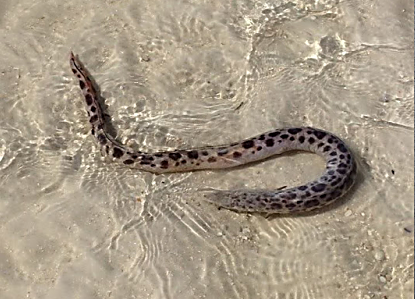
Echiophis intertinctus
What may look like a "dead snake" washed up on the beach, can sometimes turn out ito be a Spotted Spoon-nose Eel that had been stranded on the beach as the tide went out.
Once the tide comes back in and floods the beach, within a few minutes the eel will wiggle tail-first into the sand, burying itself and disappearing into its shallow underwater "den".
These eels can grow to over four feet long, have a stout cylindrical body, and a tail that is over half their body
length. The tail tip is hard and pointed, allowing the eel
to bury itself tail first, protecting itself from predators and allowing it to wait in ambush.
It hunts during the day and catches its victims with
strong pointed teeth. It is cream colored with brown spots that provide camouflage in the shallow sand and soft bottom habitat where it lives.
The burrowing behavior of marine animals such as eels serve an important purpose, as this oxygenates the marine sediments making them more habitable for other organisms.
Live shells should never be taken from any Florida State Park.